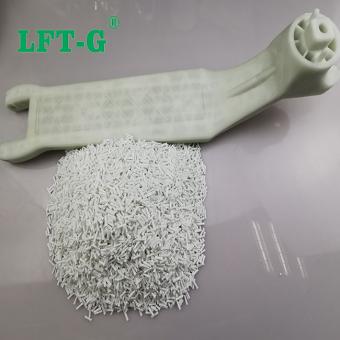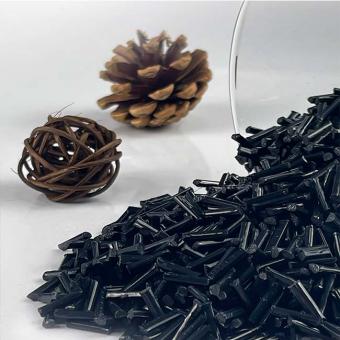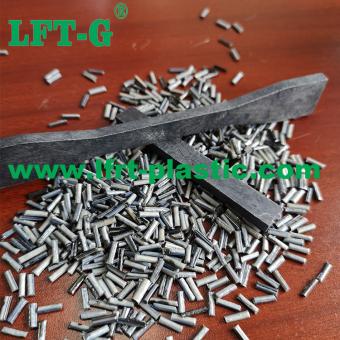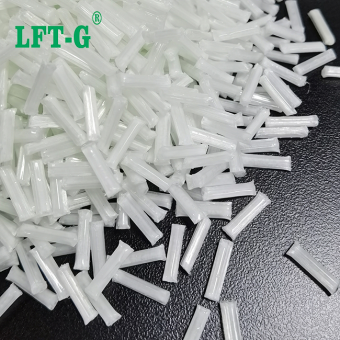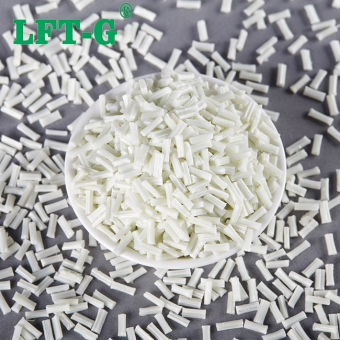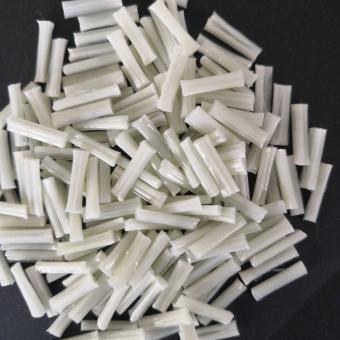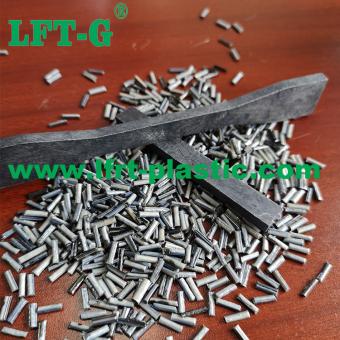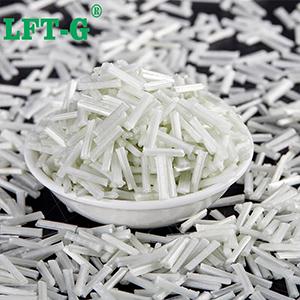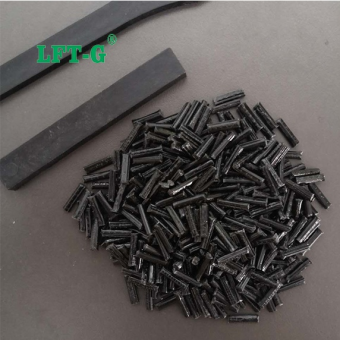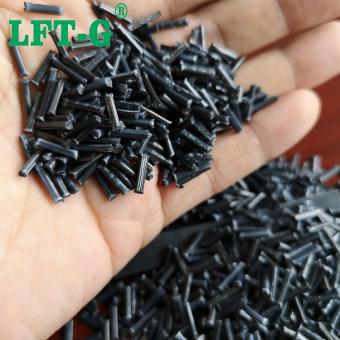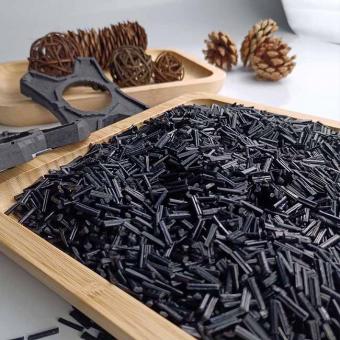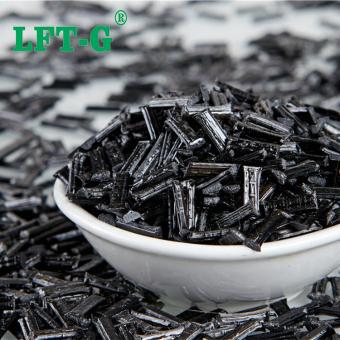-
LFT-G brand PA6 Polyamide6 nylon6 filling long glass fiber40 orginal color for automotive partsWhat is PA6 plastic? polyamide (PA), usually called Nylon, is a hetero-chain polymer containing amide group (-NHCo -) in the main chain. It can be divided into aliphatic group and aromatic group. It is the earliest developed and the most used thermoplastic engineering material. Polyamide main chain contains many repeated amide group, used as a plastic called nylon, used as a synthetic fiber called nylon. A variety of different polyamides can be prepared according to the number of carbon atoms contained in binary amines and dibasic acids or amino acids. At present, there are dozens of polyamides, among which polyamide-6, polyamide-66 and polyamide-610 are the most widely used. Polyamide-6 is an aliphatic polyamide, with light weight, strong strength, wear resistance, weak acid and alkali resistance and some organic solvents, easy molding and processing and other excellent properties, widely used in fiber, engineering plastics and thin films and other fields, but PA6 molecular chain segment contains strong polarity amide groups, easy to form hydrogen bonds with water molecules, The product has the disadvantages of large water absorption, poor dimensional stability, low impact strength in dry state and low temperature, strong acid and alkali resistance. Advantages of nylon 6: High mechanical strength, good toughness, high tensile and compressive strength. Outstanding fatigue resistance, the parts after repeated bending can still maintain the original mechanical strength. High softening point, heat resistant. Smooth surface, small friction coefficient, wear-resistant. Corrosion resistance, very resistant to alkali and most salts, also resistant to weak acids, oil, gasoline, aromatic compounds and general solvents, aromatic compounds are inert, but not resistant to strong acids and oxidants. It can resist the corrosion of gasoline, oil, fat, alcohol, alkaline and so on, and has good anti-aging ability. It is self-extinguishing, non-toxic, odorless, good weather resistance, inert to biological erosion, and has good antibacterial and mildew resistance. Has excellent electrical performance, good electrical insulation, nylon volume resistance is high, high breakdown voltage resistance, in dry environment, can work frequency insulation material, even in high humidity environment still has good electrical insulation. Light weight, easy dyeing, easy forming, because of low melting viscosity, can flow quickly. Disadvantages of Nylon 6: Easy to absorb water, water absorption, saturated water can reach more than 3%. Poor light resistance, in the long-term high temperature environment will oxidize with oxygen in the air, the color turns brown at the beginning, and the subsequent surface is broken and cracked. Injection molding technology requirements more strict, the existence of trace moisture will cause great damage to the quality of molding; The dimensional stability of the product is difficult to control because of thermal expansion. The existence of sharp Angle in the product will lead to stress concentration and reduce the mechanical strength; If the wall thickness is not uniform, it will lead to the distortion and deformation of the parts. High precision of equipment is required in post-processing. Will absorb water, alcohol and swelling, not resistant to strong acid and oxidant, can not be used as acid-resistant materials. Why filling Long Glass Fiber? PA6 has excellent properties such as light weight, strong strength, abrasion resistance, weak acid and alkali resistance and some organic solvents, and easy molding and processing. It is widely used in the fields of fibers, engineering plastics and films. However, the molecular chain segment of PA6 contains highly polar amide groups, which are easy to form hydrogen bonds with water molecules. The product has the disadvantages of large water absorption, poor dimensional stability, low impact strength in dry state and low temperature, strong acid and alkali resistance. With the development of science and technology and the improvement of life quality, the defects in some properties of traditional PA6 materials have limited its development in some fields. In order to improve the performance of PA6 and expand its application field, PA6 should be modified. Filling enhancement modification is a common method for physical modification of PA6. It refers to the modification of PA6 by adding fillers such as glass fiber and carbon fiber into the matrix to significantly improve the mechanical properties, flame retardant properties, thermal conductivity and dimensional stability of the material. What is application of PA6-LGF? Modified section of 30% long glass fiber reinforced PA6 is the ideal material for processing power tool shell, power tool parts, engineering machinery parts and automobile parts. Its mechanical properties, dimensional stability, heat resistance and aging resistance have been significantly improved. The fatigue resistance strength is 2.5 times that of unenha...
- Polyamide 6 composite
- lgf thermoplastic resin
- High impact PA6
- injection molding plastic
- pa6 filling long glass fiber
- Reinforced plastic
Tags :
-
PA6 LFT-G brand composite long carbon fiber polyamide 6 for manufacturing helmetsPA6 raw material Polyamide 6, also known as polycaprolactam or nylon 6(PA6), is a semi-transparent to opaque yellowish or milky white thermoplastic resin. The relative density of PA6 is 1.12~ 1.14g /cm3, the melting point is 219~225℃, the tensile strength is 68~83MPa, the compression strength is 82~88MPa, the low temperature resistance is good (-75℃ is not brittle), the wear resistance, self-lubricating and oil resistance is good. Due to the excellent structure and properties of PA6, more and more researchers at home and abroad have carried out important research and development on PA6, including exploring new polymerization chemicals for production, changing its structure and properties, and finding new processing methods, etc. PA6-LCF Long carbon fiber (LCF) reinforced nylon composites with high specific strength, high specific modulus, high temperature resistance and other excellent properties, expand the application space of nylon high technology field, is one of the most important reinforced composites at present. TDS Tested by us, for reference only. Application Injection technology About us Come and contact us now!
- PA6 long carbon fiber
- PA6 LCF
- Nylon 6 composite materials
- injection molding industrial plastic
- PA6 resin
- compond plastic
Tags :
-
LFT-G PEEK high quality modified materials fill long carbon fiber for automotives good performanceWhat is PEEK? Polyether ether ketone (PEEK) is a semi-crystalline thermoplastic polymer material with rigid benzene ring, compliant ether bond and carbonyl group which can promote the intermolecular force in its molecular chain. PEEK has excellent wear resistance, electrical insulation, anti-radioactivity, chemical stability, biocompatibility and thermal stability. In addition, PEEK is reusable and has a high recovery rate. PEEK is widely used in aerospace, electronic and electrical appliances, biomedicine, Marine protection, automobile industry and other fields. PEEK material is an inert material with low surface free energy, and its mechanical properties and frictional properties cannot meet the needs of some special fields. Therefore, it is necessary to modify PEEK composite material to improve its comprehensive properties. At present, filling modification and blending modification are the main methods for preparing PEEK composite materials. Filler modified reinforcement materials mainly include fiber, inorganic particles and whisker; The polymer used for blending modification should have similar polarity and solubility to PEEK. The interface modification method can improve the interface adhesion and enhance the comprehensive properties of PEEK composites. What is PEEK-LCF? As a filling system, fiber can effectively carry part of the load, and the synergistic action between fiber and PEEK can improve the comprehensive performance of composite materials. Carbon fiber and glass fiber are widely used as filler modified composites because of their high strength, high modulus and high durability. Long carbon fiber (LCF) can be used as heterogeneous nucleating agent to promote the crystallization of PEEK in composite materials, which can effectively improve the mechanical and tribological properties of composite materials. PEEK/CF composites of different lengths were prepared by injection molding, and their infiltrating and tribological properties were studied. The results show that the addition of CF increases the contact Angle and decreases the hydrophilicity of the composites. But the friction coefficient of composites is reduced and the friction resistance is improved. Long carbon fiber (LCF) has better effect on reducing friction coefficient than short carbon fiber (SCF). TDS for reference Application Q&A 1. What are the advantages of long carbon fiber materials? A: Thermoplastic LFT Long carbon fiber material has high rigidity, good impact strength, low warpage, low shrinkage, electrical conductivity and electrostatic propertiea, and its mechanical properties are better than glass fiber series. Long carbon fiber has the characteristics of lighter and more convenient processing to replace metal products. 2. Are there any special process requirements of long carbon fiber injection molding products? A: We must consider the requirements of long carbon fiber for the injection molding machine screw nozzle, mold structure and injection molding process. Long carbon fiber is a relatively high cost material, and need to evaluate the cost performance problem in the selection process. 3. The cost of long fiber products is higher. Does it has a high recycling value? A: The thermoplastic LFT long fiber material can be recycled and reused very well. We will offer you: 1. LFT & LFRT material technical parameters and leading edge design 2. Mold front design and recommendations 3. Provide technical support such as injection molding and extrusion molding
- PEEK resin lcf
- Polyether ether ketone filled lcf
- instead medal plastic peek
- injection molding platic peek
- long carbon fiber series
- higher toughness peek lcf
Tags :
-
LFT-G PP-NA-LGF20 polypropylene general grade long glass fiber 20% composite plastic 12mmWhat is long glass fiber? Long glass fiber reinforced plastic is on the basis of the original pure plastic, adding long glass fiber and other additives, so as to improve the scope of use of materials. Why filling Long Glass Fiber? 1. After long glass fiber reinforcement, long glass fiber is a high temperature resistant material, therefore, the heat resistance temperature of reinforced plastics is much higher than before without long glass fiber, especially nylon plastics; 2. After long glass fiber reinforcement, due to the addition of long glass fiber, limited the mutual movement between polymer chains of plastics, therefore, the shrinkage rate of reinforced plastics decreases a lot, rigidity is greatly improved; 3. After long glass fiber reinforcement, the reinforced plastic will not stress crack, at the same time, the anti-impact performance of plastic is improved a lot; 4. After long glass fiber reinforcement, long glass fiber is a high strength material, which also greatly improves the strength of plastic, such as: tensile strength, compression strength, bending strength, improve a lot; 5. Long glass fiber reinforced after, due to the addition of long glass fiber and other additives, the combustion performance of reinforced plastics decreased a lot, most of the material can not ignite, is a kind of flame retardant material. Why choose Long Glass Fiber instead of Short Glass Fiber? Compared with short fiber reinforced thermoplastic composites, LFT has the following advantages: • Long fiber length, significantly improve the mechanical properties of products. • High specific stiffness and strength, good impact resistance, especially suitable for automotive applications. • Improved creep resistance, good dimensional stability, high parts forming accuracy. • Excellent fatigue resistance. • Better stability in hot and humid environments. • The fiber can move relatively in the molding mold during the molding process, and the fiber damage is small. Appearance of PP-LGF Application of PP-LGF Automotive parts Front end module, door module, shift mechanism, electronic accelerator pedal, dashboard skeleton, cooling fan and frame, battery carrier, bumper bracket, underbody protection plate, sunroof frame, etc., used to replace reinforced PA or metal materials. Household appliance Washing machine drum, washing machine triangle bracket, one brush machine drum, air conditioning fan, etc., used to replace short glass fiber reinforced PA, APS metal materials. Communications, electronics, electrical appliances High-precision connectors, igniter components, coil shaft, relay base, microwave oven transformer coil frame/frame, electrical connector, solenoid valve package, scanner components, etc. Others Power tool housing, water pump or water meter housing, impeller, bicycle skeleton, skis, ground locomotive pedals, military/civil safety helmets, safety shoes, etc. are used to replace short glass fiber reinforced PA, PPO, etc. TDS for reference About us Xiamen LFT composite plastic Co., Ltd. is a brand-name company that focuses on LFT&LFRT. Long Glass Fiber Series (LGF) & Long Carbon Fiber Series (LCF). The company's thermoplastic LFT can be used for LFT-G injection molding and extrusion, and can also be used for LFT-D molding. It can be produced according to customer requirements: 5~25mm length. The company's long-fiber continuous infiltration reinforced thermoplastics have passed ISO9001 &16949 system certification, and the products have obtained lots of national trademarks and patents. We will offer you: 1. LFT&LFRT material technical parameters and leading edge design; 2. Mold front design and recommendations; 3. Provide technical support such as injection molding and extrusion molding.
- Polypropylene filling lgf
- modified pp plastic
- LFT-G brand
- PP resin lgf
- long fiber compound pp
- injection molding pp composite
Tags :
-
PA6 Nylon6 Polyamide6 composite Long Glass Fiber modified plastic 12mm in length original colorPA6 material PA6 is one of the most widely used materials in the current field, and PA6 is a very good engineering plastic with balanced and good performance. The raw materials for the manufacture of nylon 6 engineering plastic are extensive and inexpensive, and it is not restricted by the technological monopoly of foreign companies. However, in order to make good use of this inexpensive and excellent material, we must first understand it. Today, we will start with glass fiber reinforced PA6 engineering plastics, because it is the most important category of PA6 engineering plastics. Just like any other engineering plastics, PA6 has advantages and disadvantages, such as high water absorption, low temperature impact toughness and dimensional stability is relatively poor. So engineers will use different methods to make PA6 better, which we call modification. At present, the most common method is to blend and modify PA6 with glass fiber (GF). Today, we will take a look at the mechanical properties of PA6 engineering plastics under the glass fiber GF system for reference and help us select materials. PA6-LGF 1. Influence of glass fiber content on PA6 engineering plastics We can find from the application and experiment that the content index is often one of the biggest influencing factors in fiber reinforced composites. As the glass fiber content increases, the number of glass fibers per unit area of the material will increase, which means that the PA6 matrix between the glass fibers will become thinner. This change determines the impact toughness, tensile strength, bending strength and other mechanical properties of glass fiber reinforced PA6 composites. In terms of impact performance, the increase of glass fiber content will greatly increase the notch impact strength of PA6. Taking long glass fiber (LGF) filling PA6 as an example, when the filling volume increases to 35%, the notch impact strength will increase from 24.8J/m to 128.5J/m. But the glass fiber content is not more is better, short glass fiber (SGF) filling volume reached 42%, the impact strength of the material reached the highest 17.4kJ/㎡, but continue to add will let the gap impact strength showed a downward trend. In terms of bending strength, the increase of the amount of glass fiber will make the bending stress can be transferred between the glass fiber through the resin layer; At the same time, when the glass fiber is extracted from the resin or broken, it will absorb a lot of energy, thus improving the bending strength of the material. The above theory is verified by experiments. The data show that the bending elastic modulus increases to 4.99GPa when the LGF (long glass fiber) is filled to 35%. When the content of SGF (short glass fiber) is 42%, the bending elastic modulus reaches 10410MPa, which is about 5 times that of pure PA6. 2. Influence of glass fiber retention length on PA6 composites The fiber length of the glass fiber also has an obvious effect on the mechanical properties of the material. When the length of the glass fiber is less than the critical length (the length of the fiber when the material has the tensile strength of the fiber), the interface binding area of the glass fiber and the resin increases with the increase of the length of the glass fiber. When the composite material is broken, the resistance of the glass fiber from the resin is also greater, so as to improve the ability to withstand the tensile load. When the length of glass fiber exceeds the critical, the longer glass fiber can absorb more impact energy under impact load. In addition, the end of the glass fiber is the initiation point of crack growth, and the number of long glass fiber ends is relatively less, and the impact strength can be significantly improved. The experimental results show that the tensile strength of the material increases from 154.8MPa to 164.4MPa when the glass fiber content is kept at 40% and the length of the glass fiber increases from 4mm to 13mm. The bending strength and notched impact strength increased by 24% and 28%, respectively. Moreover, the research shows that when the original length of the glass fiber is less than 7mm, the material performance increases more obviously. Compared with short glass fiber, long glass fiber reinforced PA6 material has better appearance warping resistance, and can better maintain mechanical properties under high temperature and humidity conditions. TDS for your reference PA6 can be made into long glass fiber reinforced material by adding 20%-60% long glass fiber according to the characteristics of the product. PA6 with long glass fiber added has better strength, heat resistance, impact resistance, dimensional stability and warping resistance than without glass fiber added. Following TDS show the data of PA6-LGF30. Application PA6-LGF has the largest proportion of applications in the automotive industry, by electronic and electrical applications, and also involving machinery and engineering ...
- PA6 thermoplastic resin materials
- nylon 6 granules
- glass fiber reinforced plastics granules
- long fiber compounds pa6
- Injection molding plastic
- LFT-G reinforced material
Tags :
-
LFT-G raw material PPA compounds Long Glass Fiber 20%-60% higher performance instead metalWhat is the PPA material? PPA is polyphthalamide. PPA is a kind of thermoplastic functional nylon with both semi-crystalline structure and non-crystalline structure. It is prepared by polycondensation of phthalic acid and phthalenediamine. It has excellent thermal, electrical, physical and chemical resistance and other comprehensive properties. It still has excellent mechanical properties, including high rigidity, high strength, high dimensional accuracy, low warping and stability, fatigue resistance and creep resistance, under the harsh working environment of continuous high temperature, humidity, oil pollution and chemical corrosion at 200℃. What is the PPA-LGF? Long glass fiber reinforced composites can solve your problems when other methods of reinforced plastics do not provide the performance you need or if you want to replace metal with lower price plastic. Long glass fiber reinforced composites can cost-effectively reduce the cost of goods and effectively improve the mechanical properfies of engineering polymers, and increase the durability by forming long fibers to form a long - fiber - reinforced internal skeleton networkl. Performance is preserved in a wide range of environments. What is the difference compared with Short glass fiber compounds? What is the application of PPA-LGF? Bicycle accessories Mechanical parts Drive belt pulley For other applications filed please contact us, and we will give you technical support. Datasheet for reference only Certifications Quality Management System ISO9001/16949 Certification National Laboratory Accreditation Certificate Modified Plastics Innovation Enterprise Heavy metal REACH & ROHS testing Contact us, for more LFT materials
- PPA -NA-LGF40
- thermoplastic resin PPA lgf
- plastic reinforced glass fiber
- PPA filled long glass fiber plastic
- ppa composite lgf
- injection molding lft
Tags :
-
LFT-G PEEK Polyether ether ketone composite long carbon fiber thermoplastic resin original colorPEEK-LCF Polyether ether ketone (abbreviated PEEK) not only has excellent mechanical, heat and chemical resistance properties, and low friction coefficient, good bearing meshing, is another kind of good self-lubricating material after polytetrafluoroethylene (PTFE), in the bearing capacity and wear resistance than PTFE performance is better, In no lubrication, low speed and high load, high temperature, humidity, pollution, corrosion and other harsh environment is especially suitable. On this basis, the addition of carbon fiber not only enhances its mechanical properties, its friction performance has important influence. At room temperature, the tensile strength of 30% carbon fiber reinforced PEEK composite doubled, and reached three times at 150℃. At the same time, the impact strength, bending strength and modulus of the reinforced composite were also greatly improved, the elongation was sharply reduced, and the thermal deformation temperature could exceed 300℃. The impact energy absorption rate of the composite directly affects the impact performance of the composite. The carbon fiber reinforced PEEK composite shows a specific energy absorption capacity of up to 180kJ/kg. The reinforced effect of carbon fiber can also resist the thermal softening of PEEK and form a transfer film with very high strength to a certain extent, which can effectively protect the contact area. Therefore, the friction coefficient and specific wear rate of carbon fiber reinforced PEEK composite are significantly lower than that of pure PEEK. Under the same experimental conditions, the friction and wear resistance of carbon fiber reinforced PEEK composites is obviously better than that of glass fiber PEEK composites, and the improvement effect of carbon fiber on the wear resistance of materials is more than 5 times that of glass fiber with the same dosage. Carbon fiber reinforced PEEK composite material is used in parts manufacturing, which can effectively avoid the surface cracks of metal or ceramic materials, and its excellent tribological properties even exceed that of ultra-high molar mass polyethylene. TDS Application Long carbon fiber reinforced PEEK is mainly applied in the following four areas: 1. Electronic and electrical appliances PEEK can maintain good electrical insulation in the harsh environment such as high temperature, high pressure and high humidity, and has the characteristics of non-deformation in a wide temperature range, so it is used as an ideal electrical insulation material in the field of electronic and electrical appliances. The mechanical properties, chemical corrosion resistance, radiation resistance and high temperature resistance of polyether ether ketone reinforced by carbon fiber have been further improved, and its application fields have been further expanded. 2. Aerospace Polyether ether ketone PEEK has the advantages of low density and good workability, so it is easy to be directly processed into high-demand parts, and carbon fiber reinforced polyether ether ketone composite material further enhances the overall performance of polyether ether ketone, so it is increasingly used in aircraft manufacturing. The fairing on Boeing's 757-200 series aircraft, for example, is made from carbon-fiber reinforced PEEK. In addition, Gereedschappen Fabrick of Amsterdam, the Netherlands, used a 30% carbon fiber reinforced PEEK composite to build a larger component and demonstrated that its mechanical properties could be used in aircraft balancing devices. 3. Automotive Automobile energy consumption is closely related to vehicle weight. Automobile lightweight can not only reduce fuel consumption and exhaust emissions, but also improve power performance and safety, which is an effective way to save energy. In addition to the lightweight design of the structure, the use of lightweight materials is a more direct method. With its advantages of low density, good performance and convenient technology, carbon fiber reinforced polyether ether ketone composites are more and more frequently used in the automobile industry, and show great potential of replacing steel with plastic. For example, Robert Bosch GmbH uses carbon fiber reinforced PEEK instead of metal as a feature of ABS. The lighter composite part reduces moment of inertia, which minimizes reaction times, greatly enhances the overall system's reactivity, and reduces costs compared to previously used metal parts. 4. Healthcare Currently available medical polymer materials are polytetrafluoroethylene, polylactic acid, silicone rubber and dozens of kinds, but from the point of view of biomedicine, these materials are not ideal, in the use of some side effects, and PEEK resin because of its non-toxic, light weight, abrasion resistance and other advantages, is the material closest to the human skeleton, can be organically combined with the body, Therefore, polyether ether ketone resin and its composite materials have been deeply studied and applied in spine and joint...
- PEEK long carbon fiber
- peek composite plastic modified
- peek resin modified
- peek lcf lft
- long carbon fiber peek
- injection molding peek
Tags :
-
lft-g PP compounds long glass fiber high performance lgf modified plastic can be recycled 12mmPP-LGF Glass fiber reinforced PP, usually, the tensile strength of PP material is between 20M~30MPa, bending strength is between 25M~50MPa, bending modulus is between 800M~1500MPa. If PP is to be used in engineering structural parts, it must be reinforced with glass fiber. Glass fiber reinforced PP, through glass fiber reinforced PP product mechanical properties can be multiplied or even several times the improvement. Specifically, the tensile strength reaches 65MPa~90MPa, the bending strength reaches 70MPa~120MPa, and the bending modulus reaches 3000MPa~4500MPa. Such mechanical strength can be completely comparable with ABS and enhanced ABS products, and it is more heat resistant. Glass fiber reinforced PP, general ABS and reinforced ABS heat resistance temperature between 80℃~98℃, and glass fiber reinforced PP material heat resistance temperature can reach 135℃~145℃. PP filling modification, adding a certain amount of inorganic minerals in PP, such as talcum powder, calcium carbonate, titanium dioxide, mica, etc., can improve rigidity, improve heat resistance and luster; Filling carbon fiber, boron fiber, glass fiber can improve the tensile strength; Adding flame retardant can improve flame retardant property. Filling antistatic agent, colorant, dispersant, etc. can improve the antistatic property, colorability and fluidity, etc.; Filling nucleating agent can speed up the crystallization speed, increase the crystallization temperature, form more and smaller spherical crystals, thus improving the transparency and impact strength. Therefore, the filler has a significant effect on improving the performance of plastic products, improving the plastic molding processability and reducing the cost. Application As one of the four general plastic materials, PP has excellent comprehensive performance, good chemical stability, better molding performance and relatively low price; But it also has the strength, modulus, hardness is low, low temperature impact resistance strength is poor, forming shrinkage, easy aging and other shortcomings. Therefore, it must be modified so that it can adapt to the demand of the product. The modification of PP material is generally through adding mineral reinforcement toughening, weather resistance modification, glass fiber reinforcement, flame retardant modification and super toughness modification, and each kind of modified PP has a large number of applications in the field of household appliances. Glass fiber reinforced PP, can be used to make refrigerators, air conditioning refrigeration machines such as axial flow fans and cross flow fans. In addition, it can also be used to manufacture the inner drum of high speed washing machine, wave wheel, belt wheel to adapt to its high requirements on mechanical properties, for the rice cooker base and handle, electronic microwave oven and other places with high requirements on temperature resistance. Glass fiber reinforced PP. Ordinary short glass fiber reinforced PP, because the glass fiber contains short, easy warping, low impact strength, easy deformation when heated, long glass fiber can overcome the above defects of short glass fiber, and the product has a better surface, higher temperature, higher impact strength, can be used in refrigerators and kitchen appliances with high heat resistance. Glass fiber reinforced PP is on the basis of the original pure PP, adding glass fiber and other additives, so as to improve the scope of use of materials. Generally speaking, most glass fiber reinforced materials are used in the structural parts of the product, which is a kind of structural engineering materials. Datasheet Cases Xiamen LFT composite plastic Co., Ltd.
- long glass fiber polypropylene
- pp injection molding composite
- PP resin compounds
- pp lgf lft
- lgf filling pp
- pp industry use lft
Tags :
-
LFT-G Nylon 12 with filler long carbon fiber LCF 20%-60% compounds high strength lightweight 6-25mmPolyamide 12 PA12, nylon 12, also known as polydodecalactam and polylactam, is a long carbon chain nylon. There are non-polar methylene groups in nylon 12, and the number is large, which makes the flexibility of nylon 12 molecular chain larger; the amide group in nylon 12 is polar, and the cohesion energy is large, and it can form hydrogen bonds between molecules, which makes the arrangement of molecules more regular. Therefore, the crystallinity of nylon 12 is high, and the strength is also higher. Nylon 12 (PA12) has low water absorption, good low temperature resistance, good air tightness, excellent alkali resistance, grease performance, medium resistance to alcohols and inorganic dilute acids and aromatics, good mechanical properties and electrical properties, and is a self-extinguishing material. 1) Density The relative density of nylon 12 is only 1.01-1.03, which is the smallest among all engineering plastics, which has a certain effect on reducing the mass of the car and lowering the fuel consumption. If compared by unit volume, nylon 12 has advantages in price and performance. 2) Melting point The melting point of nylon 12 is 172-178℃, which is slightly lower than that of nylon 11, and it can fully meet the working temperature requirement of automobile fuel and air brake pipes. 3)Water absorption As we all know, the biggest drawback of nylon products is the large water absorption, and it is difficult to ensure the dimensional stability. However, due to the increase of methylene molecules in nylon 12, the influence of hydrophilic groups is greatly reduced, therefore, nylon 12 has the lowest water absorption rate among nylon products, which reduces the change of performance and size of products caused by water absorption, which makes nylon 12 have great advantages. After water absorption, the tensile strength of nylon 12 decreases very little, while nylon 66 and nylon 6 have great changes. 4) Impact strength Impact strength is an important technical index, and it is especially important for nylon 12 tubes that are often exposed to air. Nylon 12 at -20 ℃ and -40 ℃ according to the standard test, no fracture phenomenon, fully meet the requirements of use. Nylon 12 impact resistance is very good. 5)Low temperature performance Nylon 12 has the lowest brittleness temperature of -70 degrees Celsius, so it can be widely used for parts with low temperature resistance. 6) Flexibility The effect of plasticizers on the physical properties of nylon 12 is concentrated on the elastic modulus of the resin. There are three basic types of nylon 12 resins, the main difference between them is the different plasticizer content and the formation of different flexibility. As the content of plasticizer extractable components increases, the elastic modulus of the resin decreases. 7)Low abrasion and low friction properties Nylon 12 has excellent low-wear and low-friction properties and self-lubricating properties, so the frictional noise of Nylon 12 products is very low. 8)Fuel resistance In the automobile, the current use of oxygenated fuel, high aromatic fuel and alcohol mixed fuel will lead to the decomposition of many hose materials. Only nylon 11, nylon 12 and fluorocarbon elastomers have been tested for use in this environment. Under the action of motor fuels, all nylons dissolve, resulting in dimensional changes, especially in methanol-containing gasoline, where nylons containing large amounts of amide groups such as nylon 6 dissolve much more than nylons containing small amounts of amide groups such as nylon 12 %. It is found that the fuel containing 15% methanol has a great effect on nylon. 9) Resistant to zinc chloride solution Zinc chloride will appear in the environment under the car. Under certain temperature and humidity, the salt on the road reacts with galvanized steel or zinc-containing primer to form a small amount of zinc chloride. Zinc chloride is highly corrosive, but Nylon 12 is highly resistant to zinc chloride solutions. Ozone aging, UV exposure, temperature conditions, etc., can bring varying degrees of damage to parts and reduce service life. Since nylon 12 does not contain the + 2 3 2 + unsaturated double bond, which is susceptible to ozone attack, it does not suffer from ozone aging. In addition, the high crystallinity of nylon 12 and its high melting temperature make it more stable in terms of heat resistance, and the addition of heat stabilizers increases its heat resistance exponentially. When exposed to sunlight, its energy can cause the chemical bonds of organic materials to break. The bonding energy of C-H, C-O and C-N bonds in nylon 12 is so large that UV light is not enough to break them, but only the C-C bonds with smaller bonding energy; therefore, after adding appropriate anti-aging agents to the raw materials, the UV resistance of nylon 12 is excellent. Polyamide 12 - Long carbon fiber In the modified engineering plastics industry, long fiber reinforced composites are composites made fr...
- polyamide 12 engineering plastics lcf
- reinforced nylon 12 cfrp black
- injection molding pa12 carbon fiber
- thermoplastic resin pa12 with fiber
- LFT-G new materials pa12 cf instead metal
- green plastic recycled pa12 lcf
Tags :
-
lft-g PA66 filled long carbon fiber 20%-60% nylon 66 modified plastic instead metal lightweight smaple availableWhat is the Polyamide 6 material Polyamide resin, the English name for polyamide, referred to as PA. commonly known as nylon (Nylon), it is a macromolecule repeating units in the main chain containing amide groups in the polymer of the general term. For the five engineering plastics in the production of the largest, most varieties, the most widely used varieties. PA66 (polyamide 66 or nylon 66), compared to PA6, is more widely used in the automotive industry, instrument housings and other products that require impact resistance and high strength. What is the Long carbon fiber (LCF) In the modified engineering plastics industry, long fiber reinforced composites are composites produced by a series of special modification methods using long carbon fibers, long glass fibers, aramid fibers, or basalt fibers and a polymer matrix. The biggest feature of long fiber composites is that they have superior performance that the original material does not have, if classified according to the length of the reinforcing material added, they can be divided into: long fiber, short fiber and continuous fiber composites. As mentioned at the beginning, long carbon fiber composites are one kind of long fiber reinforced composites, which is a new type of fiber material with high strength and high modulus fiber.LCF carbon fiber composites show high strength along the fiber axis direction, and have the characteristics of high strength, light weight, etc., and have a full range of mechanical properties such as density, specific strength, specific modulus and so on which are incomparable with other materials, which is a kind of new material with excellent mechanical properties and many special functions. It is a new material with excellent mechanical properties and many special functions. What are the advantages of PA66 filling LCF 1. Good mechanical strength 2. Excellent toughness 3. Excellent wear resistance and self-lubricating properties. 4. Good oil resistance 5. Excellent gas barrier 6. Excellent fluidity and moldability. 7. Excellent heat resistance Applications More application fields you can contact us for more technical advice. Exhibitions 2023 Certifications Quality Management System ISO9001/16949 Certification National Laboratory Accreditation Certificate Modified Plastics Innovation Enterprise Honorary Certificate Heavy metal REACH & ROHS testing Main materials
- pa66 nylon fill lcf home appliance parts
- nylon66 plastic resin modified carbon black
- virgin grade pa66 high performance own factory
- Xiamen LFT-G injection molding pa66
- pa66 composites compounds high quantities good price
- own factory made pa66 lcf pellets
Tags :
-
LFT-G Polypropylene compounds long carbon fiber high performance modified plastic automotive parts 12mmThermoplastic prepreg tape composites What are thermoplastic prepreg tape composites? Composites have three elements 1: Matrix resin, e.g. PP, PA 2: Fiber, such as carbon fiber, glass fiber, and 3: fiber morphology, is one-dimensional, or fabric form, different weaving state has different properties; Prepreg is a combination of resin matrix and reinforcement made by impregnating continuous fibers or fabrics with a resin matrix under strictly controlled conditions, and is an intermediate material in the manufacture of composites. Certain properties of prepregs are carried directly into the composite material and are the basis of the composite material. The properties of the composite material depend largely on the properties of the prepreg. PP-LCF composites Long fibre reinforced thermoplastics, LFT for short, uses PP as the most common base resin, by PA, but also PBT, PPS, SAN and other resins, just for different resins need to use different fibers to achieve better results. In the automotive industry, LFT-PP (Long Fiberglass PP) is used in car hoods, instrument panel frames, battery trays, seat frames, car front-end modules, bumpers, luggage racks, spare tire trays, fenders, fan blades, engine chassis, roof racks, etc.. LCF V& SCF In contrast to LFT, SFT (Short fibre reinforced thermoplastics), the biggest difference in their appearance is the difference in the length of the particles and fibers: SFT Particle length: 1-3 mm Length of reinforcing fibers: 0.2 to 0.6 mm LFT Particle length: 6 to 25 mm Reinforcing fiber length: 6 to 25 mm Applications The earliest and most mature application of LFT-PP is in automotive parts. Due to its excellent performance and cost-effectiveness, LFT-PP is increasingly being used in other fields such as instruments, chemical equipment, power tools, gardening tools and so on. e.g. Replacement of staple fiber PA6-GF30 with LFT PP-GF50 No water absorption, higher dimensional stability No change in mechanical properties due to moisture absorption Related materials PA6-LCF PPA-LCF TPU-LCF Frequently asked questions Q. Are there any special process requirements of long carbon fiber for the injection molding products? A. We must consider the requirements of long carbon fiber for the injection molding machine screw nozzle, mold structure and injection molding process. Long carbon fiber is a relatively high cost material, and need to evaluate the cost performance problem in the selection process. Q. What are the advantages of long carbon fiber materials? A. The thermoplastic LFT long carbon fiber material has high rigidity, good impact strength, low warpage, low shrinkage, electrical conductively and electrostatic properties, and its mechanical properties are better than glass fiber series. Long carbon fiber has the characteristics of lighter and more convenient processing to replace metal products. Q. The cost of long fiber products is higher. Does it has a high recycling value? A. The thermoplastic LFT long fiber material can be recycled and reused very well.
- pp long carbon fiber reinoforced plastic modified
- natural balck color PP pellets with filler carbon fiber
- Injection mold and extrusion molding
- Injection molding LCF pp high performance
- PP polypropylene pellets polymers
- reinforced pellets 12mm length best price
Tags :
-
LFT-G modified Polyamide 6 reinforced plastic long carbon fiber filled 40% thermoplastic resin for factoryPolyamide 6 material The chemical and physical properties of PA6 are very similar to those of PA66, and the different molecular structures and properties of PA6 and PA66 also lead to different functions.PA6 has a lower melting point and a wide range of process temperatures, so it is better than PA66 in terms of impact and solubility resistance, but it is also more hygroscopic. Because many of the quality characteristics of plastic parts to be affected by hygroscopicity, molding assembly shrinkage is mainly affected by the material's crystallinity and hygroscopicity, so the use of PA6 design products should be fully considered when this point. Nylon 6 reinforced can reduce the shrinkage of PA6, an effective solution to the moisture-absorbing properties of nylon after the production of parts caused by the problem of high crystallinity, good fluidity performance, making the product more stable. Datasheet Nylon products should be used with attention to the precision error caused by thermal expansion and water absorption, poor acid resistance, poor rotational light resistance; in a long period of high temperature bias environment will be thermally oxidized with the oxygen in the air, the beginning of the color browning, and then rupture. Therefore it is not suitable for outdoor use. However, carbon fiber reinforced modified nylon can be carried out outdoor use, because it improves the poor creep resistance . The use of products with fiber reinforced PA6 not only improves poor creep resistance, but also improves rigidity, wear resistance and strength. *Tips:PA6 filling carbon fiber if not well compatible, will inevitably bring such as floating fiber, poor mechanical properties and other problems, but our products are very good compatibility, there is no such problem. Advantages 01 Strength and durability, excellent combination of rigidity and heat resistance 02 Optimized component design, perfect surface appearance, able to be applied to complex structural molding 03 Good processability, excellent fluidity and thermal stability make the material processing conditions relaxed, so that the injection molded parts miniaturization. 04 Very high thermal stability 05 Constant electrical properties over a wide range of temperatures and frequencies, ensuring 100% safety in the use of installations and equipment. Application Long carbon fiber filled PA6 add carbon fiber to enhance the material, making the products better strength, superior heat resistance, excellent impact resistance, good dimensional stability to meet the requirements of its use in industrial products and daily aspects. In recent years, the car to miniaturization, lightweight development, the engine room volume is reduced, the temperature rises, the requirements of the under-the-hood parts more resistant to high temperatures, and carbon fiber reinforced PA6 can fully meet the above requirements, so the carbon fiber reinforced PA6 automotive products in a wide variety of products, involving automotive engine parts, electrical components, body parts and airbags and other parts. Not only can play a good protective role, but also make the car more beautiful. Carbon fiber reinforced PA6 material has excellent mechanical properties, good dimensional stability, heat resistance, aging resistance has improved significantly. It is often used in automobile engine parts, mechanical parts and aviation equipment parts. Product lengthening carbon fiber reinforced nylon PA6, high fluidity, high rigidity, high mechanical strength, low shrinkage, creep resistance, good thermal stability, high tensile load, wear resistance, good toughness, oil resistance, uniformity of sub-spreading, good material gloss. Can be used for power tools, fishing gear, automobile parts, machinery parts, office accessories and so on. Certifications Quality Management System ISO9001/16949 Certification National Laboratory Accreditation Certificate Moldified Plastics Innovation Enterprise Heavy metal REACH & ROHS testing Factory Contact us
- pa6 lcf granules high rigidity strength
- PA6 long carbon fiber extrusion or injection molding
- thermoplastic resin pa6 with fiber natural black
- Nylon composite pellets Polymer granules PA6
- Long carbon fiber Reinforced Polypropylene for electrial accessories
- LFT-G pellets pa6
Tags :

 e-mail
e-mail English
English français
français Deutsch
Deutsch русский
русский italiano
italiano español
español português
português العربية
العربية 日本語
日本語 한국의
한국의 中文
中文












